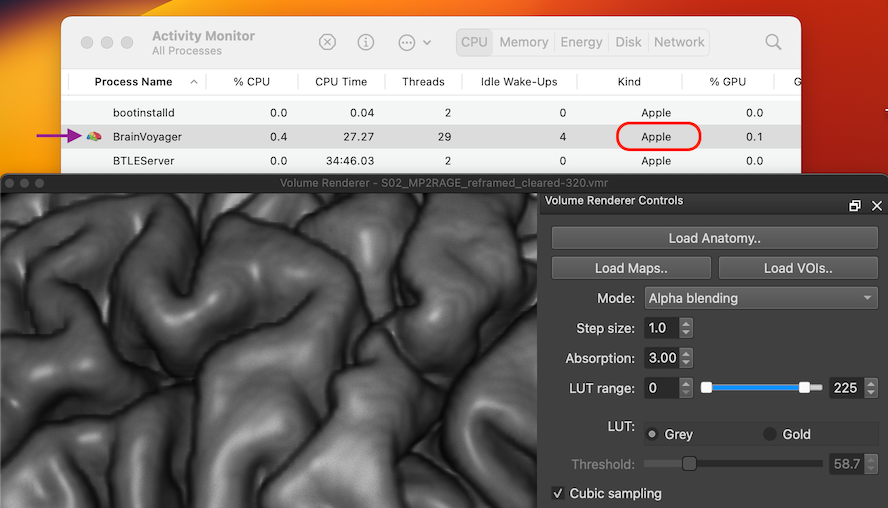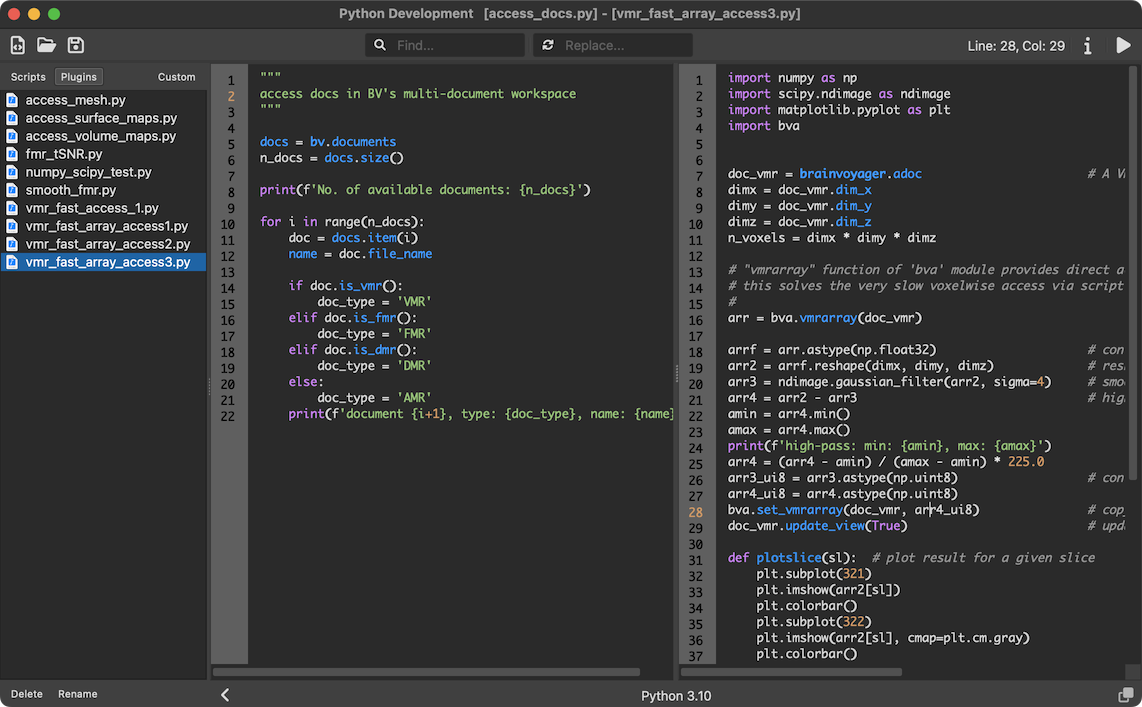Python
BrainVoyager 23 Now Available with Native Apple Silicon Support
17 10, 23
We are happy to announce the availability of BrainVoyager 23.0 and BrainVoyager 23.0 EDU! This is a major release introducing important new features. A major focus of this release was maximising the high-performance, energy-efficient capabilities of Apple Silicon Macs for BrainVoyager. Every aspect of BrainVoyager has been considered with respect to the question how to benefit best from a native Apple Silicon implementation. The result is amazing graphics and compute performance based on a native arm64 compiled binary and usage of Apple's Metal and Accelerate frameworks. The snapshot below shows an entry of BrainVoyager 23 in Activity Monitor: the "Apple" entry in the "Kind" column identifies BrainVoyager as a native Apple Silicon application.

Another highlight of this release for all platforms is the new real-time volume renderer that is partially visible in the screenshot above. While BrainVoyager always had volume rendering capabilities, this is the second time where a new implementation was needed to provide more possibilities and more advanced rendering results. Another major focus of this release was enhanced Python integration: The approach to embed the Python interpreter has been fundamentally changed (based on 'PySide6') to provide more integrated, powerful and future-proof Python support. The latter will allow in a future release to also use BrainVoyager functionality from outside the application enabling the use of any Python development environment. But also the internally offered Python IDE has been substantially improved in this release including, for example, side-by-side editors, search and replace, multi-line indentation and shell commands. A snapshot of the new Python editor is shown below.

BrainVoyager 23 also introduces Lanczos interpolation, which is an optimised windowed sinc interpolation variant that produces at least as good results as standard windowed sinc interpolation but with reduced computation time on CPU and GPU (using Metal on macOS). Furthermore, GIFTI mesh files are now supported as a native format that can be loaded like BrainVoyager .SRF files directly from the Meshes menu; GIFTI functional map ('.func.gii') and label files ('.label.gii') are also supported. These as well as many other new features, enhancements and bug fixes are described in the release notes and the updated 23.0 User's Guide that can be viewed within BrainVoyager, but also here online as well as via a beautiful eBook. To install BrainVoyager 23 for your operating system, go directly to the Downloads page of your platform:
Another highlight of this release for all platforms is the new real-time volume renderer that is partially visible in the screenshot above. While BrainVoyager always had volume rendering capabilities, this is the second time where a new implementation was needed to provide more possibilities and more advanced rendering results. Another major focus of this release was enhanced Python integration: The approach to embed the Python interpreter has been fundamentally changed (based on 'PySide6') to provide more integrated, powerful and future-proof Python support. The latter will allow in a future release to also use BrainVoyager functionality from outside the application enabling the use of any Python development environment. But also the internally offered Python IDE has been substantially improved in this release including, for example, side-by-side editors, search and replace, multi-line indentation and shell commands. A snapshot of the new Python editor is shown below.

BrainVoyager 23 also introduces Lanczos interpolation, which is an optimised windowed sinc interpolation variant that produces at least as good results as standard windowed sinc interpolation but with reduced computation time on CPU and GPU (using Metal on macOS). Furthermore, GIFTI mesh files are now supported as a native format that can be loaded like BrainVoyager .SRF files directly from the Meshes menu; GIFTI functional map ('.func.gii') and label files ('.label.gii') are also supported. These as well as many other new features, enhancements and bug fixes are described in the release notes and the updated 23.0 User's Guide that can be viewed within BrainVoyager, but also here online as well as via a beautiful eBook. To install BrainVoyager 23 for your operating system, go directly to the Downloads page of your platform:
- BrainVoyager 23.0 for Apple Silicon and Intel Macs
- BrainVoyager 23.0 for Windows 10 and 11
- BrainVoyager 23.0 for Linux
BrainVoyager 22 Now Available With Major New Features
11 12, 20
We are happy to announce the availability of BrainVoyager 22.0, which is a major release introducing important new features. The two most outstanding new features are BV Notebooks for reproducible data analysis and an advanced cortex segmentation tool that is based on a deep neural network (DNN) with an advanced "Tiramisu" architecture. These as well as other new features, enhancements and bug fixes are described in the release notes and the updated 22.0 User's Guide.
The DNN segmentation tool has been developed for high-resolution sub-millimeter data to segment grey matter with very high accuracy both along the inner (white-grey) and outer (pial) boundary. The high-quality segmentations are especially suited for cortical thickness measurements and mesoscopic (laminar and columnar) fMRI analyses.
The introduced BV Notebooks offer (script) programmers a means to write Python code to document performed analysis steps. BV Notebooks are inspired by Jupyter notebooks but they offer many BrainVoyager-specific features. Probably the most unique feature is that they support reproducible analyses also for users that do not (want to) program by converting essential GUI actions into corresponding code. Both manual as well as auto-generated code can be easily enriched with images, animations, rendered Markdown text as well as embedded BrainVoyager viewers enabling any BrainVoyager user to create rich documents. For a more detailed description of BV Notebooks, please read the BrainVoyager 22 release blog. To install BrainVoyager 22.0 for your operating system, go directly to the Downloads page.
The DNN segmentation tool has been developed for high-resolution sub-millimeter data to segment grey matter with very high accuracy both along the inner (white-grey) and outer (pial) boundary. The high-quality segmentations are especially suited for cortical thickness measurements and mesoscopic (laminar and columnar) fMRI analyses.
The introduced BV Notebooks offer (script) programmers a means to write Python code to document performed analysis steps. BV Notebooks are inspired by Jupyter notebooks but they offer many BrainVoyager-specific features. Probably the most unique feature is that they support reproducible analyses also for users that do not (want to) program by converting essential GUI actions into corresponding code. Both manual as well as auto-generated code can be easily enriched with images, animations, rendered Markdown text as well as embedded BrainVoyager viewers enabling any BrainVoyager user to create rich documents. For a more detailed description of BV Notebooks, please read the BrainVoyager 22 release blog. To install BrainVoyager 22.0 for your operating system, go directly to the Downloads page.
BrainVoyager 20 now available!
12 12, 15
A major new release of BrainVoyager is now available with many substantial new features. A first change you might observe is that the name of the software is now simply "BrainVoyager" since the "QX" part - indicating cross-platform availability - is no longer needed since BrainVoyager is known as a cross-platform product since almost 15 years now. BrainVoyager 20 is equivalent to BrainVoyager QX 3 and the latter name will also be used interchangeably for backward compatibility. While BrainVoyager 20 keeps its elegant user interface, a powerful new tool has been introduced to create, manage and document your projects. This data analysis manager tool can be used to create projects and to run basic analysis pipelines in the same way for the data of all subjects of a project. The data manager can be viewed as a batch processing tool to handle experiments no matter how big they are without the need to write scripts. In addition to batch processing, the data manager keeps track of created data and performed analysis steps in a data base providing a persistent overview of the state of all created experiments. BrainVoyager 20 also introduces automatic MNI normalisation of anatomical and functional documents, both via standard dialogs for individual data sets as well as via the new data manager for all subjects of an experiment. Other important new features include representational similarity (RSA) analysis, a new cover-flow like open documents panel and a new zoom view panel. Many enhancement for the analysis of high-resolution sub-millimetre data are available, including a masked VTC-VTC across-run registration tool and improved handling of non-1mm data for cortex-based alignment. Besides many other enhancements, there is now experimental support for an embedded Python interpreter providing an easy and unified alternative to the standard JavaScript scripting and C++ plugin development. For a more detailed description of the new features, please read the BrainVoyager 20 release blog.

